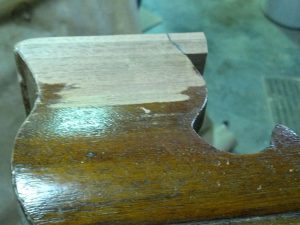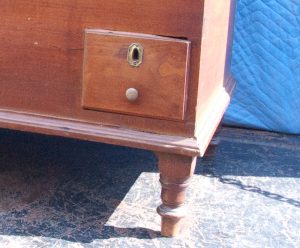We may receive a commission when you use our affiliate links. However, this does not impact our recommendations.
 Since my post on drawboring last week (read it here), I’ve gotten a number of requests for information about furniture restoration and conservation. One common thread seems to be people using those terms interchangeably. While they may both deal with repairing furniture, I’ve never thought the two terms had the same meaning.
Since my post on drawboring last week (read it here), I’ve gotten a number of requests for information about furniture restoration and conservation. One common thread seems to be people using those terms interchangeably. While they may both deal with repairing furniture, I’ve never thought the two terms had the same meaning.
Restoration is something I started doing right out of high school. The cabinetmaker for whom I worked also dealt in antiques and did repair work for several dealers and collectors in his area. He dealt (and still deals) in the kind of stuff you find at estate auctions and flea markets across the country that has a few broken parts or a ruined finish; 18th- and 19th-century stuff that just needed a little help to be functional again. Not extremely rare museum quality stuff for the most part, but good, general antiques.
It’s precisely that kind of furniture to which I apply the term “restoration.” Sometimes you get a chair that’s loose and rickety and other times a chest is missing all or part of a foot. It comes in the shop, you glue it up, tighten it up, patch it up and send it back into circulation so that people can enjoy it for years to come. There’s little or no thought to preserving, as much as possible, the original object. The idea is to fix it up and make it useful again. Furniture, regardless of how well made, is meant to be used.
 When an object is of significant historical or financial value, the way it’s treated is usually a bit different. The idea of “conservation” is to essentially freeze the object in time. Unless the piece resides (or potentially will reside) in a private home, functionality is less of a primary concern. The idea is to stop, or limit, further degradation of the piece and restore limited functionality. For instance, the drawers should open and close but the structure of the drawer and its support might not be such as to allow daily use.
When an object is of significant historical or financial value, the way it’s treated is usually a bit different. The idea of “conservation” is to essentially freeze the object in time. Unless the piece resides (or potentially will reside) in a private home, functionality is less of a primary concern. The idea is to stop, or limit, further degradation of the piece and restore limited functionality. For instance, the drawers should open and close but the structure of the drawer and its support might not be such as to allow daily use.
While a drawer lip might be repaired by letting in a patch, the repair is usually reversible. Efforts are also made to remove as little of the existing material as possible to allow the repair to be functional and relatively permanent (except for that reversible part). Again, these pieces are usually of significant historical or financial value, such as a piece that might end up in a museum setting.
Because I have differentiated between restoration and conservation doesn’t mean some of the methods don’t overlap. The hard part is trying to figure out when to restore and when to conserve. Hopefully, as I show a variety of repairs, the difference between restoration and conservation will become more apparent.
For some information on repairing finishes, check out Bob Flexner’s “Strip, Fix, Refinish” download here.
Here are some supplies and tools we find essential in our everyday work around the shop. We may receive a commission from sales referred by our links; however, we have carefully selected these products for their usefulness and quality.









Enjoyed the article. Anything that makes people think twice before opening a can of polyurethane is to be applauded. I might add that where conservation is the aim then any repairs and finishing used should be detailed for future conservators.
As a rank amateur, I would personally rather restore furniture than “conserve” it. While I can understand the desire of a collector or museum to keep as much of the original finish or veneer etc. as possible, I would rather renew old furniture for use.
Good post. I have always thought of these terms in much the same way as Chuck. I also find restoration more relevant. The idea of taking something old and broken and making it work again, while still keeping the spirit of the original seems noble to me. Not that conservation isn’t, but I don’t really relate with million dollar pieces of furniture, or their owners, as well.
The way I was taught to view these terms is based on Don William’s view which essentially: “Conservation” involves two aspects: 1. Preservation (manipulating the environment the object is in) and 2. Restoration (manipulating the object itself). With this definition, all treatments are technically “restorative” whether they are filling losses, readhering loose veneer, or cleaning the surface, etc. This is bolstered by the knowledge that no treatment is technically “reversible”. (See Applebaum’s article: http://cool.conservation-us.org/jaic/articles/jaic26-02-001.html)
Also see Jon Brandon’s answer to this question: http://www.eastpointconservation.com/faqs.html
WooHoo!